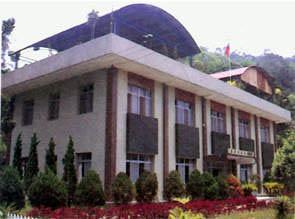About us

This center was founded in 1918 as the Medicinal Plants Cultivation Experiment Field, and is now formally known as the Lienhuachih Research Center, TFRI, MOA. The center oversees 461 ha of experimental forests, and is located at elevations of 576~925 m. The average annual temperature is 21°C, and average rainfall is 2,200 mm. We have central Taiwan's most intact, low-elevation natural broadleaf forests. The Pilushi Workstation, located near Lishan with an elevation range of 2,100~3,370 m, is classified as a temperate-zone forest with flora of natural coniferous tree stands and mixed conifer-broadleaf stands. The workstation mainly undertakes hydrological research of high-montane experimental watersheds and mid- to high-elevation forest ecological studies.
Chuyunshan Experimental Station
The Chuyunshan Experimental Station under the Center is located in Heping District, Taichung City, at an altitude of approximately 1,000-1,800 meters. The area is classified as a natural broad-leaved and coniferous broad-leaved forests. Its main mission is to collect important forest genetic resources in Taiwan to establish germplasm conservation gardens and seed gardens, establish a forest breeding and improvement base, and conduct research such as seed garden progeny testing and elite tree selection.
Research focuses
Management of the Lianhuachih Experimental Forest
A 25-ha Lienhuachih Broadleaf Forest Dynamic Plot was established in accordance with guidelines developed by the Center for Tropic Forest Science (CTFS) for undertaking long-term permanent plot studies in 2008. Through a general survey of woody plants in the permanent plot, the composition and characteristics of the region’s low elevation natural broadleaf forests can be analyzed and understood. The research results accrued can become a basic database of long-term ecological research and are helpful in fostering even more-diverse and interdisciplinary research that provide the best foundation and theoretical support for a sustainable management model of forest ecosystems in the region.
Current research on the fauna and flora of the region indicates that there are 879 species of higher plants, 78 species of wild birds, 131 species of insects and butterflies specimens, 24 species of frogs, 10 species of lizards, 11 species of other reptiles, and 20 species of mammals. A diverse and intact biota exists in the Lienhuachih region that is representation of central Taiwan's low-elevation broadleaf forests. Therefore, we continuously manage, monitor and conserve the forest ecology and natural resources.
The project for future green
Based on "the project for future green ", we collected, propagated, and preserved germplasm of endangered plants in the central Taiwan. We also performed the ex situ conservation of Taiwan's native and endangered plants. In addition, due to the historical position as a medicinal plant garden, we also collected and cultivated the indigenous medicinal plants.
Forest-gardening Therapy
In recent years, we have devoted to the development of forest-gardening therapy. Based on the high-quality of the Lianhuachih experimental forest, combined with locally produced products such as black tea, honey, and shiitake mushrooms, and incorporate "horticultural therapy" courses to develop a series of experiential courses to promote physical and mental balance.
Under-forest economy
Based on the current forestry policy, we started conducting development and promotion of under-forest economy in 2016. Up to now, Promotion items include beekeeping under forest, shiitake mushroom cultivation, Camellia formosensis, and Cinnamomum osmophloeum. We aim to create diversified minor forest products and open up new opportunities for revitalizing economic of the mountain villages.
Important research topics:
- Monitor and conservation of forest ecology and natural resources in central Taiwan.
- Perform “the project for future green” to preserve the endangered plant species.
- Establishment and extension of the forest-gardening therapy.
- Establishment and extension of the model of under-forest economy.
- Establishment of the Lienhuachih long-term forest dynamic plot and its biological resource study.
��